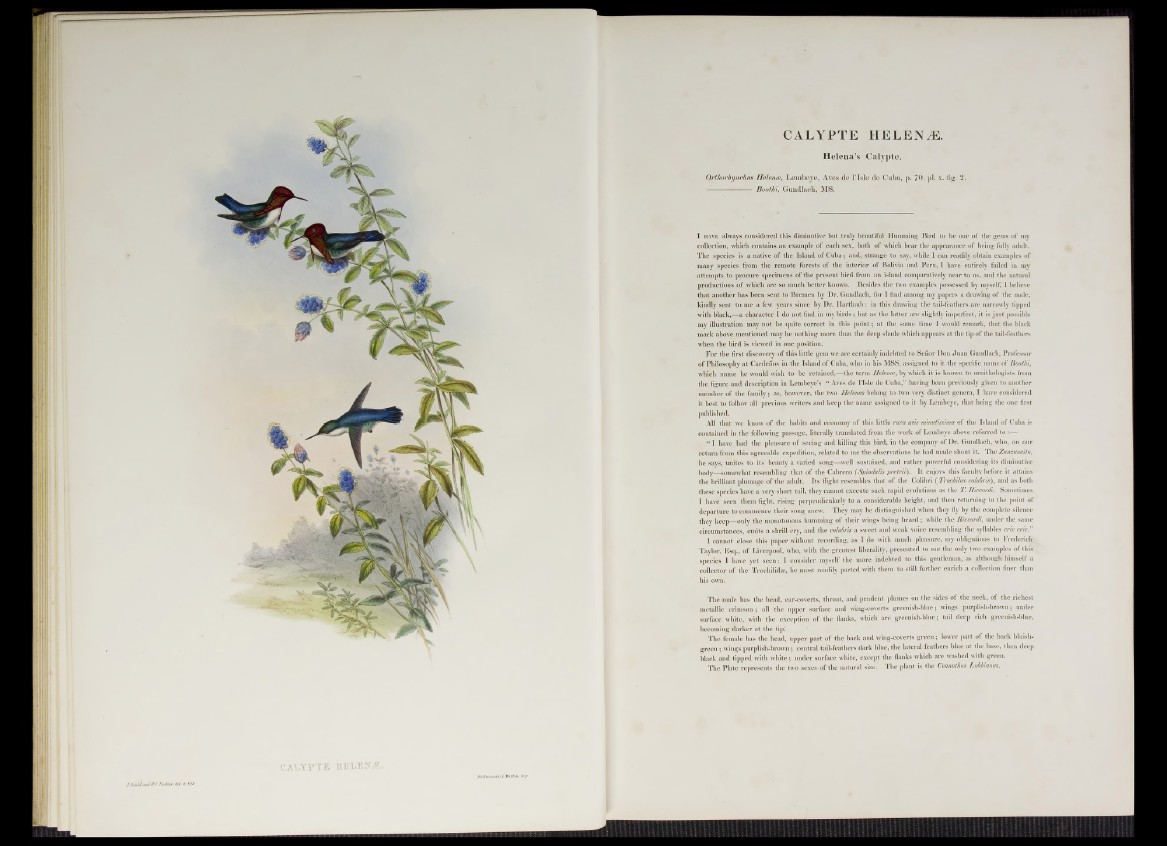
J. C,oiM ia0U3}. R iM r.d d d IM
CALYPTE HELENiE.
Helena’s Calypte.
Orthorhynclius Helena, Lembeye, Aves de l’lsle de Cuba, p. 70. pi. x. fig. 2.
------------------- Boothi, Gundlach, MS.
I h a v e always considered this diminutive but truly beautiful Humming Bird to be one of the gems of my
collection, which contains an example of each sex, both of which bear the appearance of being fully adult.
The species is a native of the Island of Cuba; and, strange to say, while I can readily obtain examples of
many species from the remote forests of the interior of Bolivia and Peru, I have entirely failed in my
-attempts to procure specimens of the present bird from an island comparatively near to us, and the natural
productions of which are so much better known. Besides the two examples possessed by myself, 1 believe
that another has been sent to Bremen by Dr. Gundlach, for I find among my papers a drawing of the male,
kindly sent to me a few years since by Dr. Hartlaub: in this drawing the tail-feathers are narrowly tipped
with black,—a character I do not find in my birds; but as the latter are slightly imperfect, it is just possible
my illustration may not be quite correct in this point; at the same time I would remark, that the black
mark above mentioned may be nothing more than the deep shade which appears at the tip of the tail-feathers
when the bird is viewed in one position.
For the first discovery of this little gem we are certainly indebted to Senor Don Juan Gundlach, Professor
of Philosophy at Cardenos in the Island of Cuba, who in his MSS. assigned to it the specific name of Boothi,
which name he would wish to be retained,—the term Helena, by which it is known to ornithologists from
the figure and description in Lembeye’s “ Aves de l’lsle de Cuba,” having been previously given to another
member of the family; as, however, the two Helenas belong to two very distinct genera, I have considered
it best to follow all previous writers and keep the name assigned to it By Lembeye, that being the one first
published.
All that we know of the habits and economy of this little rara avis mimtissima of the Island of Cuba is
contained in the following passage, literally translated from the work of Lembeye above referred to:—
“ I have had the pleasure of seeing and killing this bird, in the company of Dr. Gundlach, who, on our
return from this agreeable expedition, related to me the observations he had made about it. The Zunzuncito,
he says, unites to its beauty a varied song—well sustained, and rather powerful considering its diminutive
body—somewhat resembling that of the Cabrero (Spindalis pretrii). It enjoys this faculty before it attains
the brilliant plumage of the adult. Its flight resembles that of the Colibri ( Trochilus colubris'), and as both
these species have a very short tail, they cannot execute such rapid evolutions as the T. Riccordi. Sometimes
I have seen them fight, rising perpendicularly to. a considerable height, and then returning to the point of
departure to commence their song anew. They may be distinguished when they fly by the complete silence
they keep—only the monotonous humming of their wings being heard ; while the Riccordi, under the same
circumstances, emits a shrill cry, and the colubris a sweet and weak voice resembling the syllables cric cric."
I cannot close this paper without recording, as I do with much pleasure, my obligations to Frederick
Taylor, Esq., of Liverpool, who, with the greatest liberality, presented to me the only two examples of this
species I have yet seen: I consider myself the more indebted to this gentleman, as although.himself a
collector of the Trochilidm, he most readily parted with them to still further enrich a collection finer than
his own.
The male has the head, ear-coverts, throat, and pendent plumes on the sides of the neck, of the richest
metallic crimson ; all 'the upper surface and wing-coverts greenish-blue; wings purplish-brown; under
surface white, with the exception of the flanks, which are greenish-blne; tail deep rich greenish-blue,
becoming darker at the tip!
The female has the head, upper part of the back and wing-coverts green; lower part of the back bluish-
green ; wings purplish-brown; central tail-feathers dark blue, the lateral feathers blue at the base, then deep
black and tipped with white; under surface white, except the flanks which are washed with green.
The Plate represents the two sexes of the natural size. The plant is the Ceanothus Lobbianus.